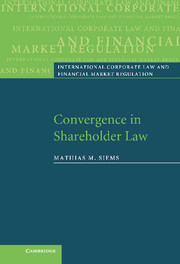Book contents
- Frontmatter
- Contents
- Preface and acknowledgments
- List of abbreviations
- Table of cases
- Table of legislation
- Introduction
- PART I The object and course of the investigation
- PART II The status quo of convergence
- PART III Developmental trends and patterns
- 7 Bases
- 8 Convergence through congruence
- 9 Convergence through pressure
- 10 Future convergences in shareholder law
- 11 Conclusions to Part III
- PART IV Conclusion
- References
- Index
7 - Bases
Published online by Cambridge University Press: 15 December 2009
- Frontmatter
- Contents
- Preface and acknowledgments
- List of abbreviations
- Table of cases
- Table of legislation
- Introduction
- PART I The object and course of the investigation
- PART II The status quo of convergence
- PART III Developmental trends and patterns
- 7 Bases
- 8 Convergence through congruence
- 9 Convergence through pressure
- 10 Future convergences in shareholder law
- 11 Conclusions to Part III
- PART IV Conclusion
- References
- Index
Summary
This introductory chapter addresses two important preliminary points for the future convergence of shareholder law. The first section analyzes how law-making functions and to what extent factual and political factors mark shareholder law (section I below). Secondly, it is clarified who exactly the decisive law-making institutions are. Thus, it is discussed whether in the future national acts of parliament or rather international and informal regulations will be of primary interest (sections II and III below).
The dependency of shareholder law
It appears to be likely that actual development and the influence of interest groups are reflected in the law. This causal relationship is not, however, a matter of course. It might also be that, conversely, law primarily influences reality, and political decision-makers feel committed to the common weal and not to private interests. Thus, it has to be clarified in which direction causality goes (subsection 1 below), why law-making institutions act in a particular way (subsection 2 below), and what role interest groups play (subsection 3 below).
The causality problem
There are differing views on the interaction between law and reality in company and securities law. One view stresses the importance of law (the ‘law matters’ thesis). First, the institutional advantages of the joint stock company as a legal form are highlighted. When in the nineteenth century restrictions on the establishment of joint stock companies were removed, waves of foundations followed, since it then became possible to pursue capital-intensive projects in a permanent, differentiated organizational form.
- Type
- Chapter
- Information
- Convergence in Shareholder Law , pp. 231 - 249Publisher: Cambridge University PressPrint publication year: 2007

